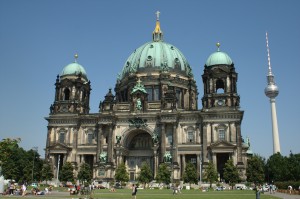Berlin Part 1
# 28 July 2012We got into Berlin in the early afternoon, and after navigating the U-Bahn metro found ourselves on Adalbertstraße in the Kreuzberg district. We had no idea how to find our hostel since it seemed to be hidden and the street numbering system in Berlin is different to that of the UK. We walked quite far down the street which seemed to grow increasingly seedier, reminiscent of Hamburg. We eventually found the amusingly named ‘Comebackpackers’ who assured us that the area was in fact safe.
Our room was a 16-bed dorm, with a 13-3 female to male ratio. This is actually a good thing as it usually leads to much less snoring. Another plus was that the Wifi in this hostel actually worked. We had a fairly quiet evening drinking €5 bottles of wine on the terrace with some Canadian and Mancunian girls from our dorm.
Next day we awoke to sweltering heat and decided to make our way to the Sandeman’s tour of Berlin, starting from the Brandenburg Gate. After scratching our heads at the U-Bahn and S-Bahn for a bit we found it, walking past the huge US embassy on the way. There were a lot of tat-touting street vendors in Parisienplatz (in front of the Brandenburg Gate) including men in faux Cold War US Army and West German military uniforms inviting you to pose with their flags for photos. Also bemusingly a woman dressed in a full gorilla costume with flip flops showing underneath, in 38C weather.
At Parisienplatz (the French embassy is on the square) we were given a sample of German humour as the tour guide showed us the statue of ‘Victoria’. It was restored after being stolen by Napoleon with its head altered to look down on the French embassy. The joke is in the name, and we were reliably assured by our American-Finnish guide that German humour did exist but was not funny.
We also saw the Hotel Adlon, where Michael Jackson famously dangled his baby from the Royal Suite window. Our guide had looked into staying in the suite, also used by Queen Elizabeth II, and told us it was €15,000 a night. We then walked along Ebertstraße to the Holocaust Memorial, which is a huge area filled with variously sized concrete blocks. The artist did not reveal any meaning behind the number or pattern of the blocks. Walking into the memorial, which dips into a valley in the centre, is very peaceful as traffic noise is blocked out. I liked the memorial as it is intended to allow more individual interpretation than traditional memorials to the 6 million Jews murdered by the Nazis. 6 million is very hard to comprehend as a number alone since it is so large.
Next we walked to the site of the Führerbunker, which is now underneath a car park. The bunker was blown up multiple times after the war and is now inaccessible. I found it very strange thinking that only 67 years ago the city was in ruins and rumbling with tanks. On the sides of one or two surviving older buildings I noticed bullet holes in the stone. Many of the ‘old’ buildings had to be extensively rebuilt after 1945.
In the sweltering heat we walked to the former site of the Gestapo headquarters, which is now a museum called the ‘Topography of Terrors’. There is a large section of the Berlin Wall, ironically protected by a fence, adjacent to it. The former site of the Berlin Wall (there were actually two, with a ‘death strip’ in the middle) is marked with twin paving stones. It follows a zigzagging path across the city.  Then we trudged on to Checkpoint Charlie, which has a replica border crossing booth, large photos of American and Soviet soldiers on their respective former sides, and its own whole range of Berlin Wall tourist tat such as fake Soviet hats and passport visa stamping.
Then we trudged on to Checkpoint Charlie, which has a replica border crossing booth, large photos of American and Soviet soldiers on their respective former sides, and its own whole range of Berlin Wall tourist tat such as fake Soviet hats and passport visa stamping.
We (from many places in Berlin) saw the television tower on Alexanderplatz, which is the tallest structure in Germany. It was built in the 60s and was intended as a show of force for the secular East German government. Unfortunately for them, a reflection dubbed the “Pope's Revenge” by Berliners thwarts their secular building ambitions quite spectacularly.


